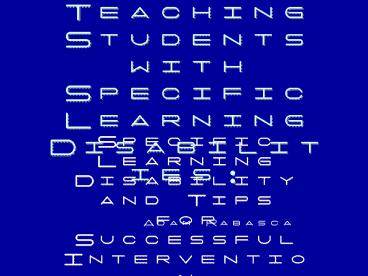Teaching Students with Specific Learning Disabilities: - PowerPoint PPT Presentation
1 / 15
Title:
Teaching Students with Specific Learning Disabilities:
Description:
Wants pawn term dare worsted ladle gull hoe lift wetter murder inner ladle ... Disk ladle gull orphan worry putty ladle rat cluck wetter ladle rat hut, an fur ... – PowerPoint PPT presentation
Number of Views:68
Avg rating:3.0/5.0
Title: Teaching Students with Specific Learning Disabilities:
1
Teaching Students with Specific Learning
Disabilities
Specific Learning Disability and Tips for
Successful Intervention
Adam Rabasca
2
Who am I?
- Education
- Bachelor of Science Degree in Environmental
Studies from UVM - Master of Science Degree in Special Education
from CUNY Hunter - Academic concentration in learning disabilities
- Professional concentration in behavioral/emotional
disabilities
- Teaching Experience
- San Rafael, California
- Bronx and Hastings, New York
- Ellsworth, Maine
- Currently at MDIHS
3
Try this!
- Wants pawn term dare worsted ladle gull hoe lift
wetter murder inner ladle cordage honor itch
offer lodge, dock, florist. Disk ladle gull
orphan worry putty ladle rat cluck wetter ladle
rat hut, an fur disk raisin pimple colder Ladle
Rat Rotten Hut.
4
What is Specific Learning Disability?
- Definition Specific learning disability (SLD)
means a disorder in one or more of the basic
psychological processes involved in understanding
or in using language, spoken or written, that may
manifest itself in an imperfect ability to
listen, think, speak, read, write, spell, or to
do mathematical calculations, including
conditions such as perceptual disabilities, brain
injury, minimal brain dysfunction, dyslexia, and
developmental aphasia.
- FYI Developmental aphasia - A severe language
disorder that is presumed to be due to brain
injury rather than because of a developmental
delay in the normal acquisition of language.
5
Eligibility in Maine
The Learning Disability Evaluation Report
- Key Components
- Processing disorder
- Average cognitive ability
- Pattern of strengths and weaknesses
- Response to Intervention (RtI) - Go for it,
Kelley! - Rule outs (Question 6 Observable Adverse
Effect) - Specially-designed instruction
Note Specific criteria often differ from state
to state.
6
Eligibility in Maine Processing disorder
- Is there a disorder in one or more of the basic
psychological processes, as demonstrated by
either - a. a score 1.5 Standard Deviations (at least 22
points) below the mean in at least one area of
psychological processing - OR
- b. a score 1 Standard Deviation (at least 15
points) below the mean in 2 or more areas.
In other words, were looking specifically at the
four areas of cognition to determine if the
student has a processing disorder.
- Verbal Intelligence Quotient Perceptual
Organization Index Working Memory Index
Processing Speed Index - Average 100
- 100 100 100 100
- 109 125 82 68
- 81 109 83 92
- For students in grades 4-12, has the student
obtained a composite standardized score no lower
than 1.5 Standard Deviations below the mean on at
least one index or scale of cognitive
functioning.
7
Eligibility in Maine Pattern of Strengths and
Weaknesses
- 3. Is the student achieving adequately for the
students age or meeting State-approved grade
level standards in all of the areas below, when
provided with learning experiences and
instruction appropriate for the students age or
State approved grade level standards?
- oral expression
- listening comprehension
- written expression
- basic reading skill
- reading fluency skills
- reading comprehension
- mathematics calculation
- mathematics problem solving
8
Rule Outs
- Is the under-achievement due to the lack of
appropriate instruction in reading or math? - Is the students lack of achievement primarily a
result of - Visual, Hearing or Motor Disability
- Mental Retardation
- Emotional Disturbance
- Environmental, Cultural or Economic Disadvantage
and/or Limited English Proficiency - Answering Yes to ANY of these questions
disqualifies the student from qualifying as a
student with a specific learning disability.
9
Specially-designed instruction?
- If a learning disability exists, does the student
require specially-designed instruction in - Reading
- Writing (including spelling)
- Mathematics
- Verbal and/or listening skills
- All of the above categories include fluency
10
Movie Time!
- F.A.T. City How Difficult Can This Be?
11
Specially-Designed Instruction
- Innumerable methods!!!
- All must be
- Structured (all components related)
- Sequenced (explicit order)
- Systematic (specific routine)
12
Examples of Commonly Used Specially-Designed
Instruction
- Reading Programs for letter-word identification
(decoding) and spelling (encoding) - Glass Analysis
- Orton-Gillingham approaches
- A multisensory approach to remediating dyslexia
created by Dr. Samuel Orton, a neuropsychiatrist
and pathologist, and Anna Gillingham, an educator
and psychologist. - LDonline.org - Examples Preventing Academic Failure, Wilson
Reading Program, Recipe for Reading - Reading methods for comprehension
- Vocabulary often first method of attack
- Reciprocal teaching (predicting, clarifying,
questioning (how/why), summarizing - Question-Answer relationship (explicit vs.
implicit questions) - Writing (encoding) programs - often bottom-up
approaches and process-oriented - ALL RELY ON GRAPHIC ORGANIZERS!!!
- Basic Writing Skills
- Diana Hanbury King
- Landmark Academy
13
Examples of Commonly Used Specially-Designed
Instruction
- Math programs and methods
- Typical method
- Concrete
- Algorithm
- Generalization
- Recipe for Math
- Kelley???
14
Classroom Accommodations and Modifications
- Modification changes to curriculum
- Examples
- Single paragraph vs. three-paragraph essay
- Book report on ability level vs. grade level
- Spelling lists on ability level vs. grade level
- Accommodation strategies for both teachers and
students - Examples
- Extended time (50) on tests/assessments
- Testing in alternative location to minimize
distractions - Provision of writing templates for
planning/organizing for all in-class/on-demand
written responses - Long-term project divided into smaller segments
with specific deadlines - Preferential seating
- Reader/Writer
- Calculator use on assessments except when
measuring calculation or math fact retention
ability - Note-taking assistance/specified
note-taker/provision of teachers notes
15
Resources
- Useful Links page on MDIHS Resource Room
Website - http//web.mdihs.net/arabasca/Resource_Room_Homep
age/Useful_Links.html - Kelleys homepage
- Contact me
- http//web.mdihs.net/arabasca/My_Homepage/Mr._Rab
ascas_Homepage.html































